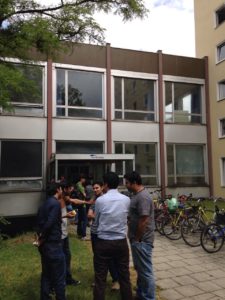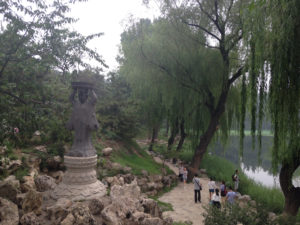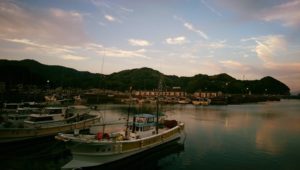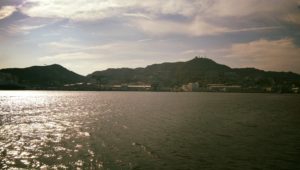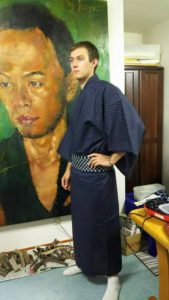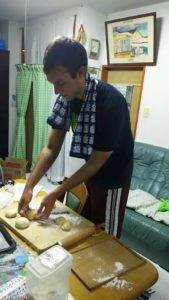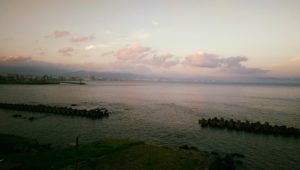And with the passing of our trip to Xi’an, we have officially reached the halfway point of our studies in China, which I find strange to think about. On the one hand I am eager to rejoin friends and family in the US, but on the other there are so many things here in China I haven’t yet seen or experienced, and there are so many things here that are simply nonexistent in the US. I suppose you could say I feel bittersweet about being halfway done. It makes me all the more want to make the most of my time here, because I don’t have much of an idea of when I might return.
That said, this past weekend was without a doubt my favorite weekend thus far. Thursday, after finishing the midterm exam, we all went to the dorms to pack and prepare for the weekend ahead. We went to Beijing’s western train station so we could board the over-night train that would take us to Xi’an. We had the nicer soft-sleeper tickets, meaning that the bed were soft and the rooms were a bit nicer, as opposed to the hard sleepers, which are more crowded and less comfortable. There were four beds to a room, two sets of bunks directly across from each other. The program bought whichever tickets were available, which meant that some rooms were entirely filled with Notre Dame students, some were partly Notre Dame students, and a couple people were alone in that respect. I happened to one of those few. I was the only Notre Dame student in my room. However, what I thought was going to be a boring and lonely night took an interesting turn. Soon after I moved all my things onto my bed, a small Chinese family, composed of a man, his mother, and his young daughter, entered the room. With my limited Chinese and his limited English, we were able to have some interesting conversations. His mother was also very kind, sharing some of their snacks with me. His 3 year old daughter seemed very smart for her age. She already knew a handful of English words and expressions, and also had an interest in natural history, so that night I learned such Chinese words as ‘fossil’ and ‘dinosaur’. Additionally, they were all natives of Xi’an, and gave me recommendations for food and drinks to have in Xi’an, as well as places to go. At the end of the train ride, we exchanged emails and he even invited me to have a meal at his house, should I return to Xi’an. So I guess if I go back to Xi’an anytime soon, I might just have a place to go! Here’s a picture of me and his daughter taken on the train.

After pulling into Xi’an that next morning, we first checked into our hotel and then set out for Xi’an’s most well known attraction: the terra cotta soldiers.The soldiers are located a little ways outside the city, amidst the hills that surround the city. The soldiers were impressive. Before us lay a number of rows of intersecting pits, each containing rank after rank of clay soldiers. The most incredible part, at least for me, was not how many soldiers there were, but the ridiculous amount of detail and work that went into each one. Literally every soldier was unique. And when they set out to build a clay army, they did just that. There were soldiers of varying ranks, distinguishable by their attire. The army had its share of slaves, foot soldiers, archers, field officers, foreign conscripts, horsemen, you name it. There was even a separate pit that depicted generals and officers having a meeting. The levels of detail was truly unbelievable.
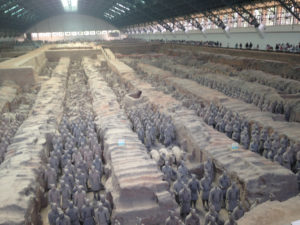

Later that evening we returned to Xi’an proper to attend a performance. Going in, we really had no idea what to expect from the performance. We knew it was based off poem or story from the Tang dynasty era, one of several dynasties that made Xi’an their capital. The performance took place just after sunset, while the sky was just turning gray. And it was soon evident why they waited until after dark to begin. The performance wasn’t a play in the usual sense. The actors had no dialogue, just a narrator speaking in an archaic Chinese, of which I could understand scarcely a word. Instead, in a way it was a dance performance on a huge scale. The set was huge, very wide and it extended deep towards the mountain behind it, at whose foot it was strategically placed. The music was excellent and the dancing was enthralling, but the most impressive part was the huge and varied amount of special effects used to help tell the story. I’ll attach some pictures that will hopefully illustrate my meaning.
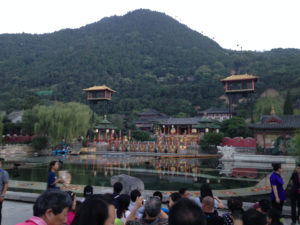

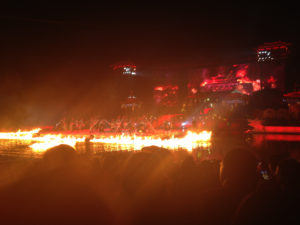

The next day we had another favorite event scheduled: biking along the city walls of Xi’an. Unlike Beijing, whose walls were demolished a few decades ago, the walls of Xi’an yet remain, and have been for the most part restored, so they are smooth enough to bike on. It was very interesting (and tiring) to bike through a significant portion of the city. In addition to old bell towers and other assorted old buildings upon the wall itself, you could also make out other landmarks within the older part of Xi’an, like Buddhist temples and pagodas that once dominated the skyline of the old city, before the advent of skyscrapers.
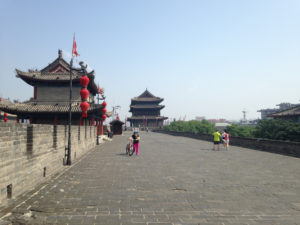

Afterward we went to an area of the city called ‘Muslim Street’. Xi’an has a decently large number of Chinese Muslims, and this area surrounds the mosque and is a huge marketplace, dotted with Muslim restaurants. It was fun to spend some time exploring the winding streets of the marketplace. I haven’t mentioned it yet, but all the food we ate in Xi’an was great. The Xi’an cuisine seems to have been influenced by the Muslim population, as there was no pork and it was dominated by beef and lamb. Just as in Beijing, I wasn’t always aware of what exactly I was eating, but it was all delicious.
The remaining destinations in Xi’an were a Buddhist temple and the Small and Large Goose Pagodas. Unfortunately the larger pagoda was being renovated, but even still you could tell they were impressive structures. And although most Buddhist temples share similar elements, I appreciated the peacefulness in the garden of this particular temple, and they were nice to explore.
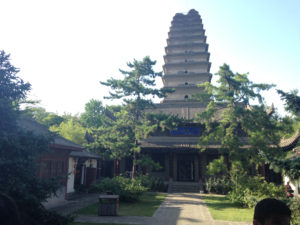
Sunday morning we made our way back to the train station to catch our bullet train back to Beijing. It had been a particularly full and exhausting weekend, but also particularly interesting. I wish we could have stayed in Xi’an a bit longer and become more familiar with the city.
